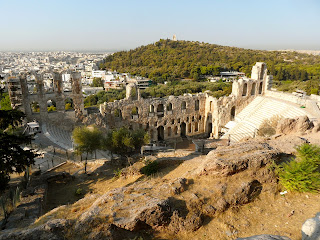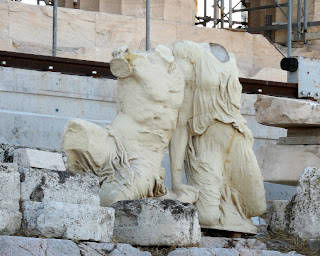NOTE: I was without
Internet for the duration of this trip, so I typed up my blog posts in advance,
while everything was still fresh. All of
them will be posted in quick succession now.
Friday August 24 ATHENS, GREECE –
Greece in August is hot as balls. It’s actually quite remarkable. But, setting that aside, it really is a
lovely country.
I had already been to Athens and various islands before I
started blogging; so my post on Athens will be admittedly lacking. But, to catch you up…
The National Archeological Museum is definitely worth a look
(my family spent about three hours just wandering the first time we visited,
but then we’re really into archeological museums.) and the Forum, the Agora,
and the Temple of Olympian Zeus are worth stopping by for a few minutes to take
pictures (there’s really not much left of any of them).
Those are the major sites I skipped this trip. Retrospectively, I wish I had made the trip
out to the Archeological Museum (basically everything except the Museum is
within walking distance of Syntagma Square) instead of going to the Benaki
Museum; but at least I now know that the Benaki museum isn’t really that
interesting.
The Benaki Museum essentially takes a look at Greek art from
Neolithic to modern day. I like
Classical Greek sculpture as much as the next girl (actually, considering my
peer group, I like Classical Greek sculpture quite a bit more than the next
girl) but I get mildly annoyed when it isn’t clearly curated. I’m pretty good with mythology, but I don’t
know all the symbols tied to each
God; so it’s nice to have a sign telling me what I’m looking at. Personally, I walk pretty quickly past the
religious Icons. I do informally study
religion for my Global Scholar certificate, but I can’t even come close to
keeping the saints straight and the older paintings of the Madonna and Child
are kind of creepy looking, so they’re mostly lost on me.
As you work your way up, the exhibits get more and more modern. The stuff from the Romantic period is
especially interesting to me because that is the period of the Greek War for
Independence. There are lots of
gloriously nationalistic paintings to be found from that period. Interestingly, during the period of
occupation by the Ottomans, the Greek Orthodox Church served as the safeguard
of Greek history, culture, and language.
Most of the precious sculptures from antiquity (for example: the
massive, ivory and gold statues of Pallas Athena from the Parthenon and Zeus
from the Athenian temple of Olympian Zeus) were stolen away by the Ottomans and
were destroyed along with most of Istanbul in a fire, but the Church protected
the history of Greek culture even in the face of occupation. So that’s pretty cool. When I was there, there was also a special
exhibit on about artists as jewelry designers, which I have to say was much
more interesting solely because it was better curated. It was very easy to figure out what I was looking
at, which is always a plus.
After the Benaki Museum, I pretty much just wandered around
down a few side streets. While I can’t
tell you what streets I was on, I found a few blocks of chocolate shops, a few
super fancy looking jewelry stores, and a supremely creepy store run by a “poet sandal maker”. The walls were
essentially lined with pictures of famous people – and occasionally family
members of famous people – who had shopped at the store, but that didn’t stop
it from feeling incredibly creepy.
According to my guidebook, that particular store is a must see in Athens
but I must disagree.
And, of course, I visited the Acropolis and New Parthenon Museum. Not quite realizing how close it
was to my hotel I took a needless metro ride one stop from Syntagma to
Akropoli. Trains in Athens come about
every 6 minutes at around 8 AM, which, if you’ve just missed a train, seems
like an interminably long period of time.
On the plus side, everything still looks very new. To me, it’s insane that the Parthenon is
still standing. Thanks to a few architectural
tricks, it has withstood a number of earthquakes, but the universe has
basically worked to destroy the building since the Persians invaded
Athens. The first time the Persians came
after what is now Greece, they burned down the Parthenon so Pericles (Full
disclosure, I thought he was another one of Shakespeare’s inventions until I
went to the Parthenon the first time I was in Athens. Then I found out he was a real dude.)
organized a campaign to rebuild a newer and better temple to Athena. That actually stuck around for a while. Then the Byzantine Christians came and turned
it into a church. To do this, they felt
it necessary loot the place and chip off a lot of the pagan friezes and
decorations. A little later it was
turned into a mosque when the Ottomans took over. These same Ottomans later stopped using it as
a mosque, and started using it to store explosive materials. This did not end well for the walls of the
temple; the ordinance exploded and took out about half of the building. After this, the ravages of time took
over. And you know what, there’s still a
building there. The propylea and the
Temple of Nike is pretty damn intact; the Estrucheon is in really good shape;
the Carytids (now located in the New Museum) are in pretty good well preserved;
there’s still an olive tree where Athena supposedly planted it; and the columns
of the Parthenon are still standing.
Sure there’s been some restoration work done (ok a lot of restoration
work), but it is amazing to me that so much is still there.
Of course so much more would be there if it hadn’t been for
that asshole Lord Elgin. It’s actually
weirdly sad to walk through the New Museum (which is gorgeous) because about
half of the artifacts have notation saying “reproduction, BM” because about
half of the remains of the Parthenon are in the British Museum. Now I get that the British stole their
diamonds, the Rosetta Stone, and a bunch of other stuff fair and square, but I
find it mildly annoying that they won’t give back the Parthenon Marbles. Greece was never a British colony. Those marbles need to go home. I mean hell, the Greeks built a whole new
museum for them. They’d have a lovely
home. In fact, the way the New Museum is
laid out, they’d have a better home. In
the British Museum, the marbles are basically at painting height, which (if
you’re even close to on the smaller side or too shy to push through masses of
people) makes them kind of hard to see through the throngs that come to look at
them every day. At the New Museum, they’re
raised so that you have to look up at them.
This makes them a lot easier to see.
So, in summation: seriously England, give back the Parthenon Marbles.
Finally I will leave you with this link. It will take you to my creative writing blog
where I have told the story of the patronage of Athens for fun. It’s definitely at the top of my list of
favorite stories from Ancient Greece, so it was kind of fun to retell. Enjoy.







No comments:
Post a Comment